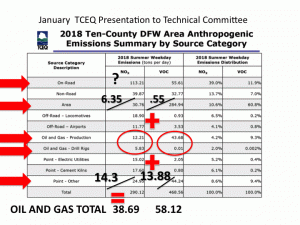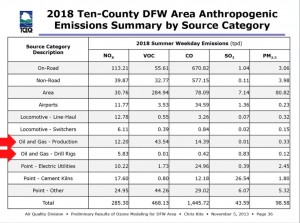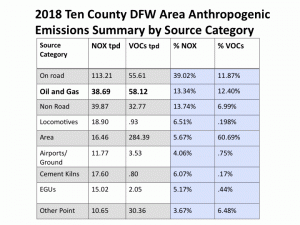Citizen Action
New Encyclopedia of Fracking Harms
 Those that keep up with these things know the rate of new information about fracking has increased almost exponentially for the past couple of years. New studies arrive monthly covering a host of subjects – air pollution, water contamination, earthquakes from injection wells, truck traffic, etc. So many it's hard to keep up and get a view above the fray. Now, at least for the next couple of months, there's a new comprehensive guide for journalists, citizens, and policymakers that tries to put all the latest evidence into one publication.
Those that keep up with these things know the rate of new information about fracking has increased almost exponentially for the past couple of years. New studies arrive monthly covering a host of subjects – air pollution, water contamination, earthquakes from injection wells, truck traffic, etc. So many it's hard to keep up and get a view above the fray. Now, at least for the next couple of months, there's a new comprehensive guide for journalists, citizens, and policymakers that tries to put all the latest evidence into one publication.
Produced by the Concerned Health Professionals of New York, the new document has the slightly unwieldy title of "Compendium of Scientific, Medical, and Media Findings Demonstrating Risks and Harms of Fracking." Clocking in at over 60 pages, it does manage to cover a lot of ground, including air and water pollution, occupational hazards, noise pollution, earthquakes, flooding, radioactive releases, climate change, agricultural threats, crime rates, property values, and the inflated economics of gas reserves. In short, for now, it appears to be the one-stop shop for everything you wish you didn't need to know about fracking, but wanted to ask.
Extensively researched and footnoted, the Compendium is something you can hand your city council member or State Representative in hopes that their superficial scanning at least produces a better appreciation for the myriad of hazards now associated with the practice.
Ask the State and Holcim To Finally Give DFW “the Holy Grail” of Cement Pollution Control Technology
 Swiss-based Holcim Cement is requesting a permit amendment to add new piece of pollution control equipment to its Midlothian cement plant, one of three cement plants that make the city the "Cement Capitol of Texas" and the largest concentration of cement manufacturing in the U.S. Good news, right? The problem is that the company is asking the state for the permit before deciding what kind of pollution control equipment to install.
Swiss-based Holcim Cement is requesting a permit amendment to add new piece of pollution control equipment to its Midlothian cement plant, one of three cement plants that make the city the "Cement Capitol of Texas" and the largest concentration of cement manufacturing in the U.S. Good news, right? The problem is that the company is asking the state for the permit before deciding what kind of pollution control equipment to install.
That's right. Holcim is asking the Texas Commission on Environmental Quality (TCEQ) to OK a permit that will result in a "major modification" of its Midlothian plant and could produce significant amounts of new pollution before it even decides what the major modification is going to be. Anywhere else in the country this might be a bit odd, but hey, it's Texas, where Rick Perry's TCEQ has a rubber stamp standing by for anything industry requests.
Holcim's permit request is being prompted by a problem complying with new federal regulations limiting a kind of pollution called Total Hydrocarbons, or THCs. These are also sometimes referred to as "Volatile Organic Compounds." Think Benzene, and other kinds of hazardous flammable gases. In its permit application Holcim says it needs to add new controls to reduce THC to levels and come under the new federal standard. Fair enough. The company then says that it's still trying to decide between two different types of controls and will make up its mind after getting the permit and seeing how well its choice works out on one of its two separate giant kilns. That's the bogus part.
But wait, there's more! The two technologies Holcim is considering installing in Midlothian are: 1) A Regenerative Thermal Oxidizer, or RTO, which is a fancy way of saying setting them on fire and flaring them off, and, 2) A Selective Catalytic Reduction unit, or SCR, which is a tower of treated metal honeycombs that pick up pollution as the plant exhaust passes through them. RTOs are already installed on American cement plants, including TXI's huge Midlothian kiln just a few miles down Highway 67 from Holcim. On the other hand, up to now full-scale commercial SCR units have only been installed on European cement plants and in fact, the Portland Cement Association has lobbied long and hard to keep them out of the US for fear of raising the pollution control bar too high for all of the country's cement plants.
That's because SCR is more expensive to build and maintain than most cement plant control devices. But for the money, you get the Holy Grail of cement plant pollution control technology.
Most of the European cement plants that have SCR units install them to remove another type of pollution from their stacks – Nitrogen Oxides (NOx). If that sounds familiar, it's because NOx is a major smog-forming pollutant, and DFW has so much of it that the region has never been in compliance with the Clean Air Act standard for smog. And you'll never guess which facilities are the single largest sources of NOx pollution in North Texas. Or maybe you will: the Midlothian cement plants. That's why Downwinders at Risk has made it a point to campaign to require all three Midlothian cement plants – Holcim, TXI and Ash Grove – to install SCR….since all the way back in 2001, when the first European units were deemed a success at a German cement plant. SCR can remove 80 to more than 90% of all NOx coming out of a cement kiln. The 6500 tons of NOx a year that the Midlothian cement plants are permitted to release could be reduced to 650 tons with the application of SCR.
Now, as it turns out, SCR units are great not only at capturing large amounts of NOx pollution, but all kinds of other industrial pollution coming out of cement plants as well. Like THCs – up to 70% or so, but also Particulate Matter, Metals, Greenhouse Gases, Carbon Monoxide, and Dioxins. It's what's called a multi-pollutant control device because it does such a good job of eliminating a wide variety of nasty stuff from smoke stacks. This is what makes it the state-of-the-art technology for communities hosting kilns. In contrast, RTOs are single-purpose pollution devices aimed just at hydrocarbon removal and aren't designed to remove other kinds of emissions.
So even though Holcim is considering operating SCR because of its hydrocarbon problem, it would have a massive impact on the plant's air pollution across the board. And if Holcim were to set the precedent, the clock would begin ticking on bringing SCR to the other two Midlothian cement plants as well. It would only be a matter of time.
The public comment period for telling the state whether to accept or reject Holcim's permit application ends this Friday, July 11th at 5 pm. (If you're interested in jumping through the hoops to fill out the online form for official comments, you can go here and use Permit Number 8996)
Downwinders is submitting detailed comments praising Holcim for considering SCR, but urging the TCEQ to reject this permit because it's too vague and doesn't commit the company to any partciular technology, including SCR. We've also been collecting letters form local officials and stare legislators that urge Holcim to definitively choose SCR.
Now we're asking you to help us bombard both the Texas Commission on Environmental Quality and Holcim's US headquarters in Dundee Michigan in the next 48 hours with the same message to show public support for the company to do the right thing while rejecting a placeholder permit that doesn't commit it to do that right thing.
We want a permit request from the company that says Holcim will definitely install SCR, becoming the first commercial application of this state-of-the-art technology in America.
Using our "Featured Citizen Action" link, you can send such a message to Austin and Michigan in a matter of seconds right now. All you have to do is click here and then send the e-mails. We guarantee there's no more important or easier thing you can do for clean air in North Texas this week than sending these e-mails to the TCEQ Commisisoners and Holcim Corporate leadership. Please help us get the cement plant pollution control technology DFW deserves. It will only take a matter of seconds for you to help us achieve a goal we've been working toward for 14 years. We can do this. But we need your help. Now. Thanks.
EPA Scientists Say Current Smog Standard Not Protective Of Public Heath Even While TCEQ Blows Off Current One
 It's been a pretty nice summer in DFW so far hasn't it? Wetter and cooler than usual. More wind. According to the stats, this past month was the first June without any 100 degree days in seven years or so. Consequently, it's also the first June in forever that hasn't seen any "Orange" or "Red" ozone alert days. If this keeps up, DFW may actually come into compliance with the 1997 ozone standard of 85 parts per billion (ppb) over an 8-hour time period – a first as well.
It's been a pretty nice summer in DFW so far hasn't it? Wetter and cooler than usual. More wind. According to the stats, this past month was the first June without any 100 degree days in seven years or so. Consequently, it's also the first June in forever that hasn't seen any "Orange" or "Red" ozone alert days. If this keeps up, DFW may actually come into compliance with the 1997 ozone standard of 85 parts per billion (ppb) over an 8-hour time period – a first as well.
But unless you think "global weirding" is going to produce these kinds of summers routinely from here on out, there's little cause for comfort. This year's cleaner air is a direct result of cooler weather. Substitute the hellish summer of 2011 for this mild one and you'd be seeing ozone alerts filling up your e-mail box. As a result, it's not out of the question we could meet the standard this year, but flunk it in 2015 if the weather reverts back to "normal."
In addition, while we may come in under the 1987 smog standard for the first time, the public health goal posts have moved with better science. In 2008, the Bush Administration lowered the acceptable level of smog to 75 ppb. That's the goal of the clean air plan that Downwinders and other groups are fighting the state over right now, saying it's not adequate to even get to that 75 ppb level.
Texas Commission on Environmental Quality staff say we don't need to implement any major pollution control measures on cement kilns, power plants, or natural gas facilities to reach this 75 ppb goal by the deadline in 2018. All we have to do is sit back and let a new federal gasoline standard hit the market in 2017 and we'll all be fine – well, except for those millions of residents who'll be breathing-in smog greater than 75 ppb on the north and western side of the Metromess. But the TCEQ staff say we'll be "close enough." No harm, no foul say the folks from the agency where smog is not considered bad for you.
But close enough should only count in horseshoes and hand grenades, not what people breathe into their lungs. And while some of us are trying to make sure the new TCEQ plan is serious about reaching an air quality goal that's now six years old, the level of ozone considered "safe" by experts is once again going down.
In a letter to EPA Administrator Gina McCarthy last week, the Agency's own Clean Air Scientific Advisory Committee (CASAC) recommended a new smog standard of between 60 and 70 ppb, saying that there's a boatload of evidence showing that the 75 ppb level is not protective of human health, and even at 70 ppb there's significant public health harm done by bad air.
"At 70 ppb, there is substantial scientific evidence of adverse effects….including decrease in lung function, increase in respiratory symptoms, and increase in airway inflammation. Although a level of 70 ppb is more protective of public health than the current standard, it may not meet the statutory requirement to protect public health with an adequate margin of safety….our policy advice is to set the level of the standard lower than 70 ppb within a range down to 60 ppb…"
This recommendation was not unexpected. Every five years, the CASAC is legally obligated to review the scientific literature to make sure the federal ozone standard is giving adequate protection to public health. The last time it did so in 2008, the panel came to a similar conclusion to lower it somewhere between 65 and 70 ppb, but the Bush Administration ignored its own scientists and chose the higher standard instead. An Obama EPA was supposed to correct that mistake when it came into office, but then-EPA head Lisa Jackson got mugged on her way to the White House by the President's re-election campaign. Any changes were put on hold until that five year review clock began ticking again. And now the official alarm has gone off on that clock. The result is a re-affirmation of the earlier findings, this time with even more science to back up the changes.
As a result, EPA will have to decide whether or not to adopt the tougher recommendations of its scientists by December 1st of this year. If they do, a new standard will be officially adopted by 2015 and we'll have to write a new clean air plan in a couple of years to achieve that goal by the end of the decade. If it doesn't, they'll be sued, with the CASAC letter as exhibit #1, and they'll lose and have to set a new standard anyway.
Why is that important to the current debate over TCEQ's plan to meet the 75 standard? Because the TCEQ plan leaves at least four monitors, spread out from Denton, to Keller, to Eagle Mountain Lake above 75 ppb – a standard that EPA scientists now say conclusively is not protecting public health.
"Close enough" to that 75 ppb level turns out to be too far away from real protection in light of the new recommendations for a standard below 70 ppb from the Science Advisory Committee. And that assumes you believe the computer modeling TCEQ has done to support its plan. To date, the state is 0 for 5 going back to 1991 in being able to accurately predict these things. If history is any indication, the state's plan will fail to reach its goal of 75 ppb at just about every one of the 20 monitors in DFW, not just four.
If you know your target of 75 ppb of smog over an 8-hour period is no longer a safe standard, and your current plan condones levels above that, it's not really a clean air plan.
December is not only when EPA must decide if it's going to pursue a lower smog standard. It's also when the state is scheduled to take public comment on its current DFW anti-smog plan. So you have the surreal possibility of holding public hearings over the merits of an already obsolete plan that isn't even serious about reaching its obsolete goal.
This is why DFW residents must demand a plan from Austin that aims lower, not higher. It's why they must demand the EPA not allow TCEQ to get away with being "close enough" to a standard that's not protecting their health. A real clean air plan would be shooting for an average of 65-70 ppb knowing that that standard will be coming down the road sooner or later. A real clean air plan wouldn't allow any monitor to exceed the current 75 standard. A real clean air plan would try to do its best to protect public health by implementing pollution control measures on the sources of smog that are the cheapest and most effective to target – Midlothian's cement plants, east and central Texas coal plants, and the natural gas industry.
And that's exactly what Downwinders and other members of the new DFW Clean Air Network are trying to do. We're pushing for stricter EPA enforcement of the 75 ppb standard, and we're pushing for adoption of "Reasonably Available Control Measures" on the cement plants and gas compressors – now, not later. Because the only way DFW breathers are going to get a better clean air plan out of Austin and Washington is by organizing for one themselves.
Highlights from Monday: How the State Hides Gas Industry Pollution
 Want to see one example of how low state bureaucrats will stoop to underplay the significance of the impact of oil and gas pollution on DFW air quality? Take a look at some slides that were part of Monday's presentation by Downwinders at Risk's Jim Schermbeck to the regional air planning meeting.
Want to see one example of how low state bureaucrats will stoop to underplay the significance of the impact of oil and gas pollution on DFW air quality? Take a look at some slides that were part of Monday's presentation by Downwinders at Risk's Jim Schermbeck to the regional air planning meeting.
In the first you'll see how the state officially ranks all the "source categories" for human-made, or "Antrhopogenic," smog-forming Nitrogen Oxides (NOx) and Volatile Organic Compounds (VOCs) pollution in North Texas (all the numbers are Tons Per Day):
Yes the pic is fuzzy, (we can land a person on the Moon but can't seem to get charts to show up with a jpeg format online) but if you squint really hard, you'll notice there are two categories for Oil and Gas pollution numbers among the more traditional "Point Sources," Off-Road, "On-Road", etc – "Oil and Gas Production" and "Oil and Gas – Drill Rigs." Looking at these two categories you might think that adding them together would produce total Oil and Gas pollution numbers. You'd be wrong.
As it turns out, there are other Oil and Gas pollution numbers hidden away in other categories in this chart not labeled "Oil and Gas." For example, in both the "Area" and "Point-Other" categories are the numbers for NOx and VOCs pollution from gas compressors. But wait, you object, aren't gas compressors an integral part of any kind of "Oil and Gas Production?" Yes, yes they are. So why aren't they included in that category instead of being stuffed anonymously in these other categories? Great question. Perhaps it has something to do with the volume of pollution they release. Because when you finally wrestle the numbers from the Texas Commission on Environmental Quality (the TCEQ didn't voluntarily offer this information), compressor pollution turns out to double the amount of smog-forming NOx released from the Oil and Gas industry in the DFW 10-county "non-attainment area." And NOx pollution is what the TCEQ keeps saying is driving our chronic smog problem. Here's the way Schermbeck presented the same TCEQ "source categories" with the compressor numbers now teased out and added to the ones already identified as Oil and Gas:
These additions raise the industry's polluter profile significantly. And that's what this next slide is doing. It's totaling all the Oil and Gas pollution and then re-ranking the categories based on these new numbers. Same totals, just different, and more honest, organization of the individual source figures. Instead of Oil and Gas emissions looking relatively small in relation to other sources like cement kilns and power plants and even locomotives, it escalates the Oil and Gas industry into one of the region's foremost industrial air polluters:
And even this much larger number is still underplaying the total amount of air pollution fracking adds to regional air quality because the state hasn't bothered to try to tease-out the "on-road" pollution that all those fracking waste and water trucks adds to the mix. State air modelers shrugged their shoulders and said they couldn't figure out how on earth to do that. Just by "Googling" the subject, Schermbeck found at least two previous studies that did that very thing – a 2005 Denton report and a 2013 Rand Corporation report that even estimated the amount of dust pollution raised by those trucks.
While those truck totals remain a mystery for now, using the TCEQ's own numbers, compressors make up at least 53% of the total NOx pollution released by the Oil and Gas industry in North Texas, and a full quarter of all VOC pollution released. According to Schermbeck, that's why they make such good targets for electrification, an air pollution control measure he was recommending as part of his larger presentation to the regional air planning committee on Monday.
This is just one example of the kind of duplicitous behavior the state of Texas is resorting to in trying to hide the true environmental and public health impact of the Oil and Gas industry. No slight of hand is too petty. Only by diligent digging by citizens is the truth coming out, ton by ton.
Schembeck's entire (unfuzzy) presentation is now online at the North Central Texas Council of Governments website as part of the June 16th agenda. It loses something without his accompanying narration but the jest of it is easily discerned for those who want to plod through it: TCEQ is doing anything but a sincere job of building a serious clean air plan for DFW. But then again, we bet you already knew that.
Rick Perry, with a Smoking Gun, in the COG Headquarters: Monday at 10 am
 The latest chapter in a decades old mystery game of "Get a Clue" happens tomorrow morning, Monday, June 16th when representatives of the Sierra Club and Downwinders at Risk present their case against the current state anti-smog plan during the regional air planning meeting at the headquarters of the North Texas Council of Governments, 616 Six Flags Road in Arlington. Come find out who and/or what keeps the DFW area from ever meeting federal clean air standards year after year and what can be done about it. The meeting starts at 10 am. Citizen groups are expected to do their presentations in the 11 to 12 hour. Then we'll all have a debriefing lunch at the Subway's down the street hosted by State Representative Lon Burnam. Y'all come.
The latest chapter in a decades old mystery game of "Get a Clue" happens tomorrow morning, Monday, June 16th when representatives of the Sierra Club and Downwinders at Risk present their case against the current state anti-smog plan during the regional air planning meeting at the headquarters of the North Texas Council of Governments, 616 Six Flags Road in Arlington. Come find out who and/or what keeps the DFW area from ever meeting federal clean air standards year after year and what can be done about it. The meeting starts at 10 am. Citizen groups are expected to do their presentations in the 11 to 12 hour. Then we'll all have a debriefing lunch at the Subway's down the street hosted by State Representative Lon Burnam. Y'all come.
Big Green Discovers It Needs More Than A DC Office to Win
 In 2010, there was a very large and coordinated push by the nation's largest environmental groups and President Obama to get climate change legislation through Congress. Even with a "Democratically-controlled Congress" it failed.
In 2010, there was a very large and coordinated push by the nation's largest environmental groups and President Obama to get climate change legislation through Congress. Even with a "Democratically-controlled Congress" it failed.
Four years later, the president has ditched Congress and is resorting to his executive authority under the Clean Air Act to initiate a cap and trade system for CO2 that reportedly will demand a 30% drop in emissions from 2005 levels from the country's existing power plants. There are lots of potential land mines in this approach – if it can survive the gauntlet of legal challenges form industry. And if it does?
"It's going to be like eating spaghetti with a spoon. It can be done, but it's going to be messy and slow," said Michael Gerrard, director of the Center for Climate Change Law at Columbia University.
As for Big Green, it's discovered that DC lobbyists and think tank policy analysts do not a movement make. Prompted by their own failure, a soul-searching New Yorker article in 2013 questioning the wisdom of a corporate-like top down approach, as well as new groups that were filling the vacuum of leadership – like the more radical and highly decentralized Keystone campaigns, a change in perspective begin to occur.
“The national environmental groups said, ‘We need to do more in-your-face activism,’ ” said Gene Karpinski, the president of the League of Conservation Voters. “You can’t just lobby members of Congress with a poll that says people support you.”
As a result the big groups have re-tooled to catch-up. They're now sponsoring more direct actions, including divestment campaigns at universities, and public protests, as well as spending big bucks in targeted state elections. They're decamping from the Capitol and spreading out their resources. In doing so, they're building new organizing models for themselves, models that take cue from smaller, more dynamic, more effective grassroots groups. It's a change for the better.
Human-Induced Earthquakes and Cooking the Planet: We’re Living the Next Hollywood Sci-Fi Blockbuster
 "Environmentalism" as a cause in America has its roots in the wilderness, the "otherness" a person can discover when he or she is separated from their own kind and put among crowds of the planet's non-human inhabitants. Walden Pond. National Parks. These were all meant to be meditative retreats from "civilization," from which you could escape. Environmentalism was a revelatory and individualistic experience.
"Environmentalism" as a cause in America has its roots in the wilderness, the "otherness" a person can discover when he or she is separated from their own kind and put among crowds of the planet's non-human inhabitants. Walden Pond. National Parks. These were all meant to be meditative retreats from "civilization," from which you could escape. Environmentalism was a revelatory and individualistic experience.
Then came the understanding of environmentalism as a way to affect collective public health. Air pollution we breathe into our bodies causes lung cancer and asthma. Swallowing water with toxins in it when you're pregnant can cause birth defects. Eating foods with pesticides in them can affect a child's hormones. Still, the impacts were mostly seen person by person, and they depended on lots of variables – genetics, location, exposure. Not in my backyard.
Now however we're in a whole new age of cause and effect. The scale is planetary. The sky we live under as well as the ground we walk on.
Imagine Hollywood makes a movie about alien invaders who want to reshape the Earth for their own purpose, say like "Battleship." They begin pumping in massive quantities of CO2 and methane, driving up the temperature way beyond anything in recent history and setting-off all kinds of chain reactions among species and weather conditions. They begin extracting minerals by poking deep holes in the earth and then setting off large explosions, the waste of which causes not-insignificant earthquake activity when they pump it back into the ground under tremendous pressure. Their huge spaceships sometimes leak radioactivity, and if they just happen to be sitting beside oceans that can be used as industrial-size septic tanks, all the better.
That's what it feels like now, in 2014.
In case you missed it, the United States Geologic Service issued its very first "Earthquake warning" for Oklahoma:
"A new study found that earthquakes in Oklahoma rose by 50 per cent over the last seven months, leading researchers to warn that the risk of a damaging earthquake measuring a magnitude of more than 5.5 has increased significantly in the state. Agencies reported 183 earthquakes of magnitude 3.0 or higher from October until April 14th, compared with an average of only two per year from 1978 to 2008."
Usually reserved for places like California or Alaska to warn residents of the risk of damaging aftershocks, this is the first time the USGS has issued an earthquake warning for a state east of the Rockies. In the Sooner State, the aftershocks are thought to be caused by fracking waste injection wells. A Cornell University study released this week showed a link between waste wells and earthquakes up to 50 kilometers away.
"A new study of the Jones earthquake swarm, occurring near Oklahoma City since 2008, demonstrates that a small cluster of high-volume injection wells triggered earthquakes tens of kilometers away. Both increasing pore pressure and the number of earthquakes were observed migrating away from the injection wells.
"The existing criteria for an induced earthquake do not allow earthquakes associated with the well activity to occur this far away from the wellbore," said Katie Keranen, assistant professor of geophysics at Cornell University, who led the study of the Jones earthquake swarm. "Our results, using seismology and hydrogeology, show a strong link between a small number of wells and earthquakes migrating up to 50 kilometers away" said Keranen. "
Moreover, we're just beginning to understand the threat to infrastructure from human-induced earthquakes…
"Last week scientists attending the Seismological Society of America annual meeting in Anchorage, Alaska called for more research into the relationship between fracking wastewater disposal and earthquake activity.
Gail Atkinson, an earth sciences professor at the University of Western Ontario, presented research at the conference highlighting the “significant and as-yet-unquantified risk” to the integrity of critical infrastructure, such as major dams and nuclear power plants posed by induced seismicity.
Part of the problem is that fault lines in the areas most affected by fracking operations are often poorly and incompletely mapped. Texas, Ohio, Colorado and Oklahoma, which have in recent years experienced unprecedented seismic activity, have never been made a priority like California and other states where quakes have long been a threat."
SMU and USGS scientists looking into the Azle earthquake swarm were also at this same Alaska conference presenting their paper showing the vast majority of recent earthquakes near that city were centered between two injection wells, including a large XTO one. Expect to see some follow-up as reporters and citizens take their first look. And while we really do expect an alien invasion to occur before the State of Texas voluntarily does anything to stop the problem in Azle, there's a House Energy Committee, Seismic Activity Sub-Committee hearing next Monday May 12th, where only invited testimony will be heard. Sharon has the details for folks that want to make another trip to Austin.
Meanwhile, April saw new highs in atmospheric poisoning.…
The end of April has arrived, and with it, the record for the first month in human history with an average carbon dioxide level in Earth’s atmosphere above 400 parts per million has been set.
With a little more than 24 hours left in the month, the average for April can't slip below 400 ppm. “Every day in April has been over 400 ppm,” said Pieter Tans, a climate scientist with the National Oceanic and Atmospheric Administration.
The levels of carbon dioxide in the atmosphere are monitored from a site atop Hawaii’s Mauna Loa volcano, where they have been measured continuously since 1958. The long record has charted the steep rise of the greenhouse gas — the most prevalent in Earth’s atmosphere — as a result of human emissions.
The first measurement in excess of 400 ppm was made on May 9, 2013. This year, the level rose above that mark a full two months earlier, and has remained above 400 ppm steadily since the beginning of April.
And lest you think you'll be long gone before the effects of this change affect you and yours, yesterday's new National Climate Assessment report wants you to know that,
"The effects of human-induced climate change are being felt in every corner of the United States, scientists reported Tuesday, with water growing scarcer in dry regions, torrential rains increasing in wet regions, heat waves becoming more common and more severe, wildfires growing worse, and forests dying under assault from heat-loving insects.
Such sweeping changes have been caused by an average warming of less than 2 degrees Fahrenheit over most land areas of the country in the past century, the scientists found. If greenhouse gases like carbon dioxide and methane continue to escalate at a rapid pace, they said, the warming could conceivably exceed 10 degrees by the end of this century.
“Climate change, once considered an issue for a distant future, has moved firmly into the present,” the scientists declared in a major new report assessing the situation in the United States."
Conscience-ridden scientists making dire warnings about the threat. A government too slow or self-interested to act to thwart the threat. We know this movie. From the POV of the moving camera, we see the same forces of darkness making things go boom underneath us are also filling up our thin layer of atmosphere with gunk. This is no longer something we can escape from, nor is it a matter of local public health. After years of hearing that the sky is falling, now it really is. Only instead of aliens causing it, it's us treating the planet as if we were.
In such a Hollywood Blockbuster, the heroes would be the scrappy, common-sense fueled citizenry who had managed to outrun and outsmart the aliens in various small and large ways while governments fumbled and greedy privateers made deals with the newcomers. With some imagination, a rag tag group of locals fighting a single alien ship out in the boondocks would finally find an out-of-the-box way to disrupt, confuse, and eventually defeat the enemy. As the credits begin to roll, you can see word of this grassroots strategy spread across the globe and its effectiveness showing up in Paris, Moscow, Nairobi, Mexico City, and Hong Kong.
This is that movie. We're in it. Are you a member of the scrappy resistance or an anonymous uncredited crowd extra? Quick, the tide's coming in.….
Thank You. Citizens Might Have Just Saved The Local Air Planning Process…From Itself
 A year from now, last Thursday' meeting in Arlington may be seen as a turning point.
A year from now, last Thursday' meeting in Arlington may be seen as a turning point.
Local residents refused to let the air quality planning process die, showing up in numbers that forced officials to switch to a larger room, and making sure their opposition to another state "do-nothing" air plan was heard loud and clear.
Their participation had already changed the day's agenda. Included was a breakthrough UNT study that directly challenges the Texas Commission on Environmental Quality's claim that natural gas emissions don't increase DFW smog.
UNT's Dr. Kuruvilla John's presentation of the new study received quite a bit of media coverage, before, during, and after Thursday's meeting. You can find some of the best coverage by clicking on the links below.
UT-Austin Study Reveals "Underestimates"
Dr. John's presentation influenced another researcher's slide show as well. Scheduled to speak about older, more generic ambient air measurements for ozone, Dr. David Allen of UT Austin instead presented more recent research into gas pollution as well.
Overlooked in the debut of the UNT study, Allen's constant monitoring of one drill site in Fort Worth revealed that the TCEQ was underestimating emissions from the pneumatic valves at the site by 159%.
That was news to both citizens and TCEQ, who said they hadn't looked at Allen's research and hadn't corrected their inventories to account for such underestimates. Valves like these are powered by natural gas, are quite numerous on gas equipment, and account for a large percentage of VOCs released from a fracking site.
A Better Picture of Oil and Gas Pollution
Citizen cross-examination of TCEQ staff members present at the meeting also revealed a different look at the volume of Oil and Gas industry pollution in the 10-county DFW "non-attainment area"
Up to Thursday, TCEQ was dispersing Oil and Gas pollution across several categories, making it impossible to show the true total impacts.
Here's an example of the way TCEQ likes to present the info:
SOURCES OF SMOG-FORMING NITROGEN OXIDE POLLUTION (NOx)
IN DFW's NON-ATTAINMENT AREA
1. "On Road" vehicles 113.21 tons per day
2. "Non-Road" vehicles" 39.87 tpd
3. "Area" 30.76 tpd
4. "Other Point Sources" 24.95 tpd
5. "Locomotives" 18.90 tpd
6. "Cement Kilns" 17.60 tpd
7. "Electric Utilities" 15.02 tpd
8. Oil and Gas Production 12.21 tpd
9."Airports" 11.77 tpd
10. Oil and Gas Drill Rigs 5.83 tpd
TOTAL 290.12 tpd
This makes it look like Oil and Gas pollution is not that big a deal.
But it turns out TCEQ is hiding 28.44 tpd of NOx gas compressor pollution in the "Area" and "Other Point Source" categories.
This was brought out in questioning on Thursday. Once you add these figures to the other Oil and Gas emission numbers spread out over different categories, this is what you get:
SOURCES OF SMOG-FORMING NITROGEN OXIDE POLLUTION (NOx)
IN DFW's NON-ATTAINMENT AREA
1. "On Road" vehicles 113.21 tpd
2. Oil and Gas Industry 46.48 tpd
3. "Non-Road" vehicles 39.87 tpd
4. "Locomotives" 18.90 tpd
5. "Cement Kilns" 17.60 tpd
6. "Area" 15.93 tpd
7. "Electric Utilities" 15.02 tpd
8. "Other Point Sources" 11.34 tpd
9. "Airports" 11.77 tpd
TOTAL 290.12
(Earlier today we put out an e-mail alert that left 10 tons off the "Area" category in this second chart, greatly affecting its ranking. That mistake is corrected in this version of the chart and we apologize for any confusion that might have caused)
When you quit playing the state's shell game with Shale pollution, the Oil and Gas industry becomes the region's second largest source of NOx pollution – the kind of pollution TCEQ says is the main driver of smog in DFW (not even counting all the pollution from O&G fracking trucks still hiding in the "On Road" category).
There have been control measures for cars to reduce NOx. There have been controls on heavy duty equipment and trucks to reduce NOx. There have been new controls on locomotives to reduce NOx pollution. There have been controls on airport ground equipment to reduce NOx pollution. There's even been middling controls to reduce the NOx from the Midlothian cement kilns. But where's the controls to reduce NOx from the Oil and Gas industry – the one source in this list that hasn't had the same kind of regulatory attention? Good question – save it for next time.
Citizen Participation is Crucial
This is the kind of close examination the TCEQ hopes to avoid by limiting debate on this new clean air plan, scheduled to be submitted to EPA by July next year. And it's exactly why citizens need to keep showing up.
Because of the momentum and interest coming out of Thursday's meeting, citizens also got the next scheduled pow-wow of the local air planning process moved up to late May or early June instead of waiting until July.
We're already taking suggestions for what you want to see on that agenda, so don't be shy. And thank you again for restoring some tiny amounts of integrity into a process that's been swamped by Rick Perry's indifference.
You're making a difference, and that's all anybody can do. This last Thursday it was a big difference. Let's try to do the same in May.
Some Coverage of Thursday's Air Planning Mtg.
Channel 8: "UNT researchers say fracking a contributor to North Texas smog problem"
Texas Observer: "Studies: Links Between Fracking and Smog Pollution Stronger Than State Claims"
Star-Telegram: "Natural Gas Production Contributing to Higher Ozone Levels, study Finds"
Denton Record Chronicle: "Officials: No New Plans to Clean Up Air"
HOW YOU CAN SAY "THANK YOU" BACK
Here's what Downwinders at Risk did this past week to make sure Thursday's air quality meeting wasa success:
1) Pressed for and got the UNT study linking fracking to smog on the meeting agenda after being told it would not be included.
2) Sent out releases to the media advertising the UNT presentation.
3) Sent out alerts to you and others to let you know about the new UNT study and the meeting itself.
4) Sent out a "Citizens' Guide to the Meeting" so you could be prepared for Thursday.
5) Showed-up at Thursday's meeting with handouts showing the lack of air quality progress in DFW and the lack of a complete plan by TCEQ
6) Used our questions to reveal how TCEQ was hiding Oil and Gas industry pollution totals in their data
7) Pressed for and got an earlier "next meeting" of the local air quality planning group
8) Sent out this follow-up so that everyone knows what went on and what the news is from the meeting
A local forum for clean air issues was about to disappear.
Only the last month's mobilization of citizens prevented that from happening on Thursday.
Who began that mobilization?
We did.
We really need your financial help to keep doing this. We don't get state or national funding – just local money from people like yourself.
Thanks. We very much appreciate it.
We Won a Small Victory – Now Come Take Advantage of It
 This is why citizen participation matters.
This is why citizen participation matters.
Last week, local officials were balking at reserving a slot at next Thursday's regional air planning meeting for a presentation by UNT researchers on how gas industry emissions from the Barnett Shale could be adding to DFW's chronic smog.
After reading about the UNT research in the Denton Record Chronicle, Downwinders at Risk and State Representative Lon Burnam specifically asked the local Council of Governments to include the UNT work on the agenda.
At first, we were told that there was already one technical presentation scheduled for the meeting and there wouldn't be any time for a second.
That struck us as strange, since in the past, every such meeting has always had more than one technical presentation.
When we pointed this out in an e-mail with links to past meeting agendas to prove the point, we quickly got a different response. Suddenly, there would be time for the UNT presentation.
That wasn't so hard was it? All it took was a little logical push back. But if we hadn't supplied it, Thursday would be looking a lot different.
Now, we're asking you to please come and help us push back a little more.
State environmental officials are on record as saying the air pollution from gas mining and production in the Barnett Shale is not adding to DFW's smog.
A lot of us think otherwise.
Come next Thursday, on the 17th, you can listen to the new UNT research on fracking air pollution and ask Texas Commission on Environmental Quality officials directly what makes them so sure that gas pollution isn't hurting local air quality.
Because the format of these regional clean air meetings are now so informal, anyone in the audience can ask questions of a presenter. That means you – if you show up.
It doesn't matter if you don't know the technical lingo. This is all about wind direction, weather, and things that pollute. There are no stupid questions.
The new anti-smog plan that the state is building needs all the public scrutiny it can get. It needs tough examination by people who care about clean air and the truth.
Next Thursday, you can help us put the state on the spot.
This is the first opportunity in 2014 to speak up and sound off about our decades-long smog problem. Don't let the TCEQ leave town without hearing from you.
We fought and won the right for you to listen to this research because we thought it was important. Won't you please come and take advantage of this victory?
We need a good showing to prove DFW residents are still mad about breathing dirty air.
NEXT THURSDAY, APRIL 17th
10 am to 12pm
North Central Texas Council of Government headquarters
616 Six Flags Drive
(After the meeting, State Representative Lon Burnam and Downwinders will be hosting a lunch time de-briefing, location to be decided, so stay tuned.)
Look, we know this is a small victory. But state officials don't want to talk about how gas industry pollution may be making our local smog worse, even though there's evidence that it is.
That's exactly why we think we need to keep bringing it up.
Winning the right to hear a new scientific presentation on the connection between gas pollution and smog may not seem like much of a win, but it is when the Powers-That-Be don't want you to hear it.
We know that small victories like this can lead to larger successes.
In the 1990's the same state agency that's now denying gas pollution has any impact on DFW smog was saying exactly the same thing about the Midlothian cement plants.
It took lots of push back from citizens who knew better before we got the state to admit it was wrong.
Now, Ellis County is in the DFW non-attainment area and the cement plants have controls on them they would otherwise never have.
We need the same effort in 2014 to show the state is as wrong about gas industry pollution as it was about the cement plants.
Right now, Downwinders is the only group committed to organizing citizens around clean air issues in DFW.
But we just lost a funding source that was critical to us and we need your help to keep the pressure on. This money paid for staff work in the field.It's very easy to give securely online here, or you can send checks to our P.O. Box at the bottom of the page.
We really need your help. Thank you.
The Biggest Fracking Fight That Isn’t Being Fought – DFW Air Plan Mtgs This Month
 Since fights over fracking began in the Barnett Shale, they've been mostly fights over specific permits, leases, or rules fought in one city at a time.
Since fights over fracking began in the Barnett Shale, they've been mostly fights over specific permits, leases, or rules fought in one city at a time.
Other than an occasional trip to Austin or DC to stop or support some piece of legislation, the action takes place in whatever community is putting up the most resistance. Front lines are fragmented and move around a lot. There's not a single cause that's united the energy from the multitude of ad hoc groups and individual "fracktivists" into a focused campaign for regional change. The closest thing to more encompassing battles have been the recent victories in Dallas and the current kickass campaign in Denton. These feel like old Cold War skirmishes – proxy clashes standing in for the on-going larger war over the Barnett Shale's soul.
But from now until the summer of 2015 there's a regional fracking fight waiting to be fought. It involves new bureaucracies and terms and mechanics, so it makes a lot of traditional fracking foes nervous. But the payoff is the potential to affect change throughout a 10-county area, including the heart of the urban Barnett Shale – Tarrant, Parker, Denton, Johnson, Wise and Ellis – as well as Dallas, Collin, Kaufman, and Rockwall.
What's the fight? It's over the new regional anti-smog plan, called a State Implementation Plan, or SIP. When a region hasn't met the federal standard for smog, also called ozone, it has to submit a plan to the EPA to explain how it's going to comply by the end of a three-year deadline. Despite at least three previous plans, DFW has never met the 1997 federal standard for smog. It's 85 ppb, or "parts per billion" concentration over 8 hours measured by approximately 20 stationary monitors scattered over the area. The closest we've come has been 86 ppb of ozone in 2009.
The new DFW plan is supposed to be designed to meet an even more ambitious target – no monitor higher than a three-year running average of 75 ppb of ambient air by 2018. We're at 87 ppb now. To reach the new goal, DFW would have to drop 12 parts per billion in ambient smog levels in four years -something that's never happened before.
Ozone/smog is created by a combination of Nitrogen Oxides (NOx) from combustion sources and Volatile Organic Compounds (VOCs) from combustion sources and evaporation sources mixing in daylight. The more sun, the more ozone.
What are combustion sources of NOx and VOCs? Power plants and cement kilns. Every boiler and furnace and oven. Every internal combustion engine. Every diesel engine. Anything with a flame or a spark.
What are evaporation sources of VOCs? Gasoline pumps,tanks and paint shops.
An anti-smog plan is supposed to look at all the sources of smog-forming pollution in a region and find the cheapest and easiest ways to reduce it. Past plans have been responsible for putting more controls on coal-fired power plants and the Midlothian cement plants, as well as creating HOV lanes and tightening inspection standards for vehicles. But one large category of smog-forming emissions has been left largely untouched by past air plans – the gas and oil industry.
It's not because gas and oil sources aren't capable of contributing to DFW smog. Start with all the trucks that are needed for each well and the NOx and VOC emissions they produce. Then the drilling rig itself. Some cities now require electric motors, others still allow diesel and the NOx and VOCs they produce. Think about all the chemicals being dumped into a well and then flowing back out, many of them VOCs. Flares are sources of both NOx and VOCs. Storage tanks and pipelines are huge sources of escaped evaporated VOCs. Diesel compressors are huge sources of NOx. There isn't a part of the oil and gas fuel cycle that doesn't produce smog-forming pollution.
It's not because the oil and gas emissions are insignificant. In 2011, the Texas Commission on Environmental Quality estimated that the VOCs being released by all the oil and gas facilities in the DFW area were greater than the volume of VOCs being released by all the cars and trucks on the road in the same region. In 2012, a Houston Area Research Council report estimated that a single flare or compressor could raise downwind ozone levels 3 to 5 parts per billion as far as five to ten miles away.
No, the oil and gas industry haven't been touched by these state anti-smog plans because the state doesn't want to impose new regional regulations on an industry. It's nothing personal. Austin doesn't want to impose new regulations on any industry. The last serious SIP was in 2007 – before the Barnett Shale boom and Rick Perry's presidential campaign. Since then, it's been one excuse after another from TCEQ about why no new controls are necessary – even though DFW air quality progress has stopped and we're still in violation of a 20-year old smog standard.
It's also true that the oil and gas industry hasn't been touched by an air plan because no one's made them. No DFW anti-smog plan has been the focus of a fracking campaign like the recent Dallas Trinity East permits, or the Denton petition drive. There been no pressure on state government to respond to a regional demand for action.
But the new DFW air plan does offer gas activists a chance to get reforms outside of their own city limits. For example, it could be the goal to include mandatory electrification of compressors in this plan. It's been estimated that 60 % or more of the air pollution from the gas fuel cycle comes from compressors. Electrification doesn't solve all their air pollution problems but it takes a huge bite out of them because the compressors are no longer being run by locomotive size diesel engines. Electrification of new compressors and a phase-in to replace existing diesel engines could reduce not just smog pollution, but toxic air pollution and greenhouse gases by thousands of tons a year.
Even if Austin rejects such proposals, there's a part of every plan called the "Weight of Evidence" category that's more inclusive to voluntary measures. A recommendation for cities and counties to demand electrification of all compressors in the DFW region isn't as immediate as a state-sponsored mandate, but it's an official good housekeeping seal you can take to local city councils and pass one by one until it does become a de facto regional policy. This is exactly what happened with Downwinders' Green Cement procurement campaign from 2007-2011 aimed at getting rid of old wet cement kilns in Midlothian. A short recommendation to local governments about where to buy their cement in the 2007 SIP was turned into a model ordinance by Dallas and then passed by a dozen other entities, one by one, over the next two years. by the end of this year, there will be no wet kilns lift in Midlothian.
The same thing could happen with compressors in this new plan, or green completions, or tanks, or pipelines in this new DFW air plan – if activists are willing to invest the same amount of time and energy into a regional fight as they do in their own backyard battles.
You have a couple of chances in April to dip your toes into the SIP Process. This coming Sunday, April 6th, from 3 to 5 pm at the Texas Campaign for the Environment office in Dallas, State Rep Lon Burnam and Downwinders at Risk will be hosting a strategy meeting for folks who want to know more about how to take advantage of this new air plan. Central to this strategy is involving more gas activists to win a regional fight, so y'all come.
Then on April 17th, at 10 am at the North Central Council of Governments Headquarters in Arlington, there's a meeting of the SIP "technical committee" that will be hearing presentations from the state and others about DFW's smog problem. Don't let the "technical committee" name fool you. These are open to the public and anyone can attend. In fact, this is your chance to ask questions of the state and the experts.
And to make it more interesting, we think we've managed to convince the Powers That Be to include UNT graduate student Mahdi Ahmadi's presentation on Barnett Shale contributions to DFW ozone as part of the April 17th meeting. This was the study recently featured by Peggy Heinkel-Wolfe in the Denton Record Chronicle:
According to the results, the air monitoring sites surrounded by oil and gas production activities, generally on the west side of DFW, show worse long-term trends in ozone reduction than those located farther from wells on the east side of DFW.
His spatial analysis of the data showed that ozone distribution has been disproportionally changed and appears linked to production activities, perhaps an explanation why residents on the western side of DFW are seeing more locally produced ozone, particularly since 2008.
If this one fails, another new air plan will not be due until at least 2019 or 2020 at the earliest. This is our only chance until then to affect the gas industry over a wide area instead of just one permit or one city at a time. Let's try to make it count.
DFW Anti-Smog Plan Strategy Meeting
Sunday April 6th 2-5 pm
Texas Campaign for the Environment Offices –
3303 Lee Parkway #402 • Dallas, TX 75219 – across from Lee Park
Hosted by St. Rep. Lon Burnam and Downwinders at Risk
DFW Air Plan Committee Meeting – open to the public
10 am to 12 noon
Thursday April 17th
North Central Texas Council of Governments
616 Six Flags Drive, Arlington – across the street from the amusement park


